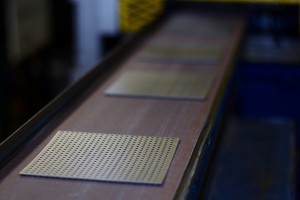Choosing the Right Perforated Metal Pattern
Comments Off on Choosing the Right Perforated Metal Pattern Perforated metal has applications in a wide spectrum of industries, ranging from pharmaceutical to construction. It is created through metal stamping and characterized by a pattern of holes in a sheet or strip of metal. Depending on its intended use, perforated metal comes in a number of standard, as well as a wide variety of custom holes sizes, shapes and arrangements to meet the special requirements of each application. To select the right perforated metal, you may have to consider variables such as strength, applications, and ratios in hole and bar size.
Perforated metal has applications in a wide spectrum of industries, ranging from pharmaceutical to construction. It is created through metal stamping and characterized by a pattern of holes in a sheet or strip of metal. Depending on its intended use, perforated metal comes in a number of standard, as well as a wide variety of custom holes sizes, shapes and arrangements to meet the special requirements of each application. To select the right perforated metal, you may have to consider variables such as strength, applications, and ratios in hole and bar size.Strength Considerations in Perforated Metal
The strength or stiffness of perforated metal sheets can be a crucial factor when used in stress conditions. This is especially the case when it is used as a protective layer in sound-proofed walls, as well as outdoor barriers or even pieces of furniture. Naturally, perforated metal is not as strong as non-perforated metal.
However, the two are compared to establish strength levels of perforated metal. This allows design engineers to determine what thickness of perforated metal will deliver the same strength of non-perforated metal. The strongest hole shape and pattern for any given percentage of open area is a 60-degree staggered, round hole pattern.
Selecting Perforated Metal for Specific Applications
The application of the perforated metal is another important factor. Perforated metal can be used to sound-proof rooms, shield radiation, and distribute heat, among many other uses. As an acoustic barrier, it causes sound waves to move in and out of the holes quickly, absorbing them into a sound absorptive layer underneath.
Perforated metal is also used in microwave ovens to contain radiation while letting heat pass through. The effectiveness of perforated metal in all of these various applications, however, depends on the size and number of holes in the sheet.
Hole and Bar Size in Perforated Metals
As a result, you should also consider the ratio between hole and bar size in a sheet of perforated metal. Bars are the spaces between the holes, occupied by metal. The balance between holes and bars in a sheet of metal can affect its strength and efficiency in different applications. Narrow bars indicate larger holes, while wide bars suggest smaller ones.
While the variations of hole and bar sizes are virtually countless, your options may be limited by the general rule that the material thickness of the metal being perforated should not exceed either the hole size or bar width of the pattern. There are exceptions to this rule, but keeping this general rule in mind during your application planning is advised. This is to reduce the likelihood of tool failure during manufacture.
To choose the right perforated metal pattern for your application, you may have to consider a number of key factors. The strength, application and distribution of holes and bars in perforated metal all have an effect on its functionality and efficiency.
Non-Metallic Perforated Products
Many plastics, vinyls, laminates and composites can be perforated, as well as non-metallic coatings and coverings bonded to metals. If you are considering such an application, let us know!
If you need assistance in selecting a perforated metal pattern, the experts at Metalex can help. Contact us today or download our eBook, Proper Selection for Perforated Products.









